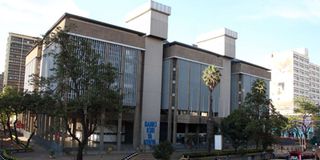Banks set to step up loan recovery as defaults mount

The Central Bank of Kenya headquarters in Nairobi in this picture taken on September 15, 2020.
Banks are rolling their sleeves as they prepare to go after people who have been unable to service loans they took mostly during the Covid-19 period, leading to an increase in Non-Performing Loans (NPL).
As part of the credit recovery efforts, the banks intend to allocate more resources on recovery of loans, including through the use of external parties in the recovery process.
This is according to a credit survey by the Central Bank of Kenya (CBK) covering the quarter ending June 30, 2020, which revealed that many banks were preparing to start credit recovery efforts in the following quarter.
“For the quarter ended September 30, 2020, banks expect to intensify their credit recovery efforts in nine of the eleven economic sectors. The intensified recovery efforts are aimed at improving the overall quality of the asset portfolio,” the CBK report stated.
“The banks intend to allocate more resources on monitoring and recovery of loans as well as use of external parties in the recovery process,” it added.
This was after the banks recorded an increase in NPLs, where seven of the 11 sectors categorised by banks recorded cases of borrowers failing to pay back the money on time. An NPL is a loan in which a borrower hasn’t made the scheduled payments for a period of at least 90 days.
According to banks, between April and June, the levels of NPLs increased in the tourism, restaurant and hotels, transport and communication, and personal and household, trade, real estate, building and construction, and manufacturing sectors. However, in the financial services, mining and quarrying, energy and water and agriculture sectors, , the levels remained unchanged.
“The increase in NPLs was mainly due to a challenging business environment as a result of COVID-19 pandemic,” the CBK survey states.
“Sixty-four percent of the respondents indicated that NPLs are likely to increase in the third quarter of 2020 as a result of the global COVID-19 pandemic, resulting to a challenging business environment. The respondents indicated that all the eleven economic sectors will be affected negatively by the pandemic.”
Credit recovery
As a result, the banks indicated their intention to intensify credit recovery efforts in order to reduce NPLs and the sectors being targeted are Real Estate (77 per cent), Trade (75 percent), Personal and Household, Building and Construction (74 per cent), Tourism, Restaurant and Hotels, and Transport and Communication (72 per cent).
“Credit recovery efforts are expected to remain unchanged in the Mining and Quarrying, and Energy and Water since the level of bad debts in these sectors is low,” the CBK report stated.
The survey noted that the ratio of gross loans to total assets decreased from 56.94 per cent in the quarter March 31, 2020 to 55.85 per cent in the quarter ended June 30, 2020.
Thirty-eight commercial bankd and one mortgage company participated in the survey, which sought to establish the lending behavior in the banking sector in respect to all the eleven economic sectors.
Focus was on demand for credit, credit standards for approving loans, level of interest rates, NPLs, the effect of repeal of capping of interest rates2 on lending to Small and Medium sized Enterprises (SMEs), credit recovery efforts, implementation of International Financial Reporting Standards (IFRS 9) on Financial Instruments and implementation of IFRS 16 on Leases.
Overall, the survey identified that the banking sector recorded growth between April and June, compared to the period between January and March.





